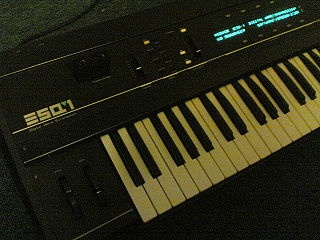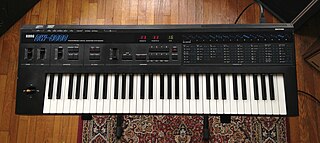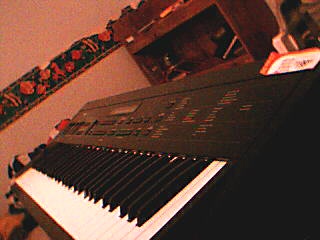
The Yamaha DX7 is a synthesizer manufactured by the Yamaha Corporation from 1983 to 1989. It was the first successful digital synthesizer and is one of the best-selling synthesizers in history, selling more than 200,000 units.

Novation Digital Music Systems Ltd. is a British musical equipment manufacturer, founded in 1992 by Ian Jannaway and Mark Thompson as Novation Electronic Music Systems. Today the company specializes in MIDI controllers with and without keyboards, both analog and virtual analog performance synthesizers, grid-based performance controllers, and audio interfaces. At present, Novation products are primarily manufactured in China.

Ensoniq ESQ-1 is a 61-key, velocity sensitive, eight-note polyphonic and multitimbral synthesizer released by Ensoniq in 1985. It was marketed as a "digital wave synthesizer" but was an early Music Workstation. Although its voice generation is typically subtractive in much the same fashion as most analog synthesizers that preceded it, its oscillators are neither voltage nor "digitally controlled", but true digital oscillators, provided by a custom Ensoniq wavetable chip. The signal path includes analog resonant low-pass filters and an analog amplifier.

The Yamaha CS-80 is an analog synthesizer introduced by Yamaha Corporation in 1977. It supports true 8-voice polyphony, with two independent synthesizer layers per voice each with its own set of front panel controls, in addition to a number of hardwired preset voice settings and four parameter settings stores based on banks of subminiature potentiometers.
The Yamaha AN1x is a DSP-based analog modeling synthesizer, produced by Yamaha Corporation from 1997 to 1998, and was marketed as an "analog physical modelling control synthesizer".
The Yamaha TX81Z is a rack-mounted (keyboard-less) frequency modulation (FM) music synthesizer, released in 1987. It is also known as a keyboard-less Yamaha DX11. Unlike previous FM synthesizers of the era, the TX81Z was the first to offer a range of oscillator waveforms other than just sine waves, conferring the new timbres of some of its patches when compared to older, sine-only FM synths. The TX81Z has developed a famous reputation, largely based on some of its preset bass sounds. The Yamaha DX11 keyboard synth was released the following year, offering improved editing abilities.

The Korg DW-8000 is a polyphonic hybrid digital-analog synthesizer released in 1985. It blends digital waveforms with an analog filter and amplifier, followed by a digital delay for adding echo effects. It boasts eight-note polyphony and its keyboard is equipped with velocity sensitivity and aftertouch.

The Korg Wavestation is a vector synthesis synthesizer first produced in the early 1990s and later re-released as a software synthesizer in 2004. Its primary innovation was Wave Sequencing, a method of multi-timbral sound generation in which different PCM waveform data are played successively, resulting in continuously evolving sounds. The Wavestation's "Advanced Vector Synthesis" sound architecture resembled early vector synths such as the Sequential Circuits Prophet VS.

The Yamaha CS2x is a sample-based synthesizer released by the Yamaha Corporation in 1999. The CS2x is designed for maximum real-time control, according to Yamaha. It is the successor of the very successful Yamaha CS1x. Enhancements include 64-note polyphony, a bigger sample ROM, a 24 dB/oct LPF/HPF filter and a two-band EQ per part/layer. The CS acronym stands for Control Synthesizer.

Roland JX-8P is a 61-key, velocity- and aftertouch-sensitive, six-note polyphonic, almost entirely analog synthesizer released by Roland in 1985. In a time of rising popularity of digital frequency modulation synthesizers, such as Yamaha DX7, JX-8P was marketed as the best of both worlds: while it was possible to create classic analog synth sounds, several new modulation parameters and redesigned hardware enabled it to produce certain types of sounds associated with FM synthesis, such as metallic percussive sounds. Likewise, traditional hands-on controls were replaced with a Yamaha DX7-style interface with membrane buttons and one "edit" slider.
The Yamaha V50 is a hybrid music workstation introduced in 1989. It combines a sequencer, rhythm machine, an FM synthesis-based sound module and a MIDI keyboard.

Yamaha SY77 is a 16 voice multitimbral music workstation first produced by Yamaha Corporation in 1989. The SY77 is a synthesizer whose architecture combines AFM synthesis, AWM2 for ROM-borne sample-based synthesis, and the combination of these two methods christened Realtime Convolution and Modulation Synthesis (RCM). The same technology was also packaged in a rack-mounted module released simultaneously, the TG77.
The Yamaha FS1R is a sound synthesizer module, manufactured by the Yamaha Corporation from 1998 to 2000. Based on Formant synthesis, it also has FM synthesis capabilities similar to the DX range. Its editing involves 2,000+ parameters in any one 'performance', prompting the creation of a number of third party freeware programming applications. These applications provide the tools needed to program the synth which were missing when it was in production by Yamaha. The synth was discontinued after two years, probably in part due to its complexity, poor front-panel controls, brief manual and limited polyphony.

The Korg DS-8 is a digital eight-voice FM synthesizer released by Korg in 1987. Following an agreement with Yamaha for access to its research and development facilities, it was designed using Yamaha components and constructed under a licensing agreement. It introduced an analog-style interface for controlling FM sounds and could play different patches on each of its eight voices, marking it as Korg's first multi-timbral MIDI synthesizer. Accompanying its launch was the Korg 707, a more portable version of the DS-8, lacking digital effects but equipped with strap pegs for keytar performance.
The Roland Alpha Juno is a series of analog polyphonic synthesizers introduced by Roland Corporation in 1985. The Alpha Juno 1 and Alpha Juno 2 were released at the same time, and feature the same sound engine but with the latter boasting additional performance features. The Alpha Junos were a departure from their predecessor, the Roland Juno-106, as they replaced the dedicated controls with soft touch buttons and a single dial for programming sounds. One of the factory presets, nicknamed a 'hoover sound', became a staple in jungle and rave music.

The Split-8 is a polyphonic analogue keyboard synthesizer manufactured by Sequential Circuits. Built in Japan and going by the alternative name Pro-8 in some markets, this was one of the last synthesizers produced by the company and was assigned model number 608. It was released in 1985 at a list price of $1,199. This and some other Sequential Circuits synthesizers were built around the Curtis Electronics CEM 3394 "synth-on-a-chip" integrated circuit, and used a Z80 as their central microprocessor.

The Korg DW-6000 is a polyphonic hybrid digital-analog synthesizer released in 1985. It blends digital waveforms with an analog filter and amplifier, also incorporating a chorus effect to create an enriched analog sound. The DW-6000 features six-note polyphony and was quickly succeeded by the DW-8000, also released in 1985, which introduced a velocity sensitive keyboard with aftertouch, a built-in arpeggiator, increased polyphony and waveforms, and substituted the chorus effect with a digital delay effect.

The Yamaha DX21 is a digital controlled bi-timbral programmable digital FM synthesizer with a four operator synth voice generator which was released in 1985. It uses sine wave-based frequency modulation (FM) synthesis. It has two FM tone generators and a 32-voice random-access memory (RAM), 32 user voices and 128 read-only memory (ROM) factory preset sounds. As a programmable synth, it enables users to create their own unique synthesized tones and sound effects by using the algorithms and oscillators. The instrument weighs 8 kg (17.6 lbs). On its release, it sold for $795.

The Yamaha DX100 is an FM synthesizer released by Yamaha in 1986. It offers four operators for each of its eight voices, and has eight algorithms. It has only 49 mini-keys, and no arpeggiator or effects, but is still useful, known in particular for its bass patch #1. It features up to 192 presets, seriously improving the DX7's limited preset capabilities. It can also store 24 user-programmable sounds in RAM. It lacks cartridge support, but voice patches can be saved to and loaded from an external cassette recorder.
The Yamaha DX9 is a spin off synthesizer of the family of the DX7 built by Yamaha. It uses FM synthesis and has 16 note polyphony; however, it only has four FM operators for sound generation compared with six on the DX7. It is the least complex of the DX range of synthesizers and has only 20 on board memory locations.















